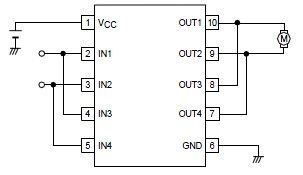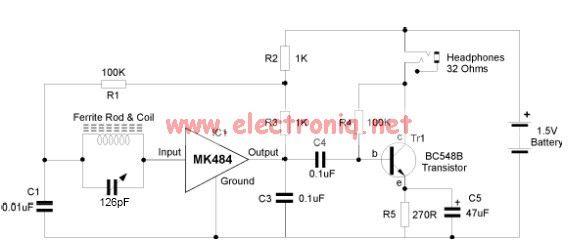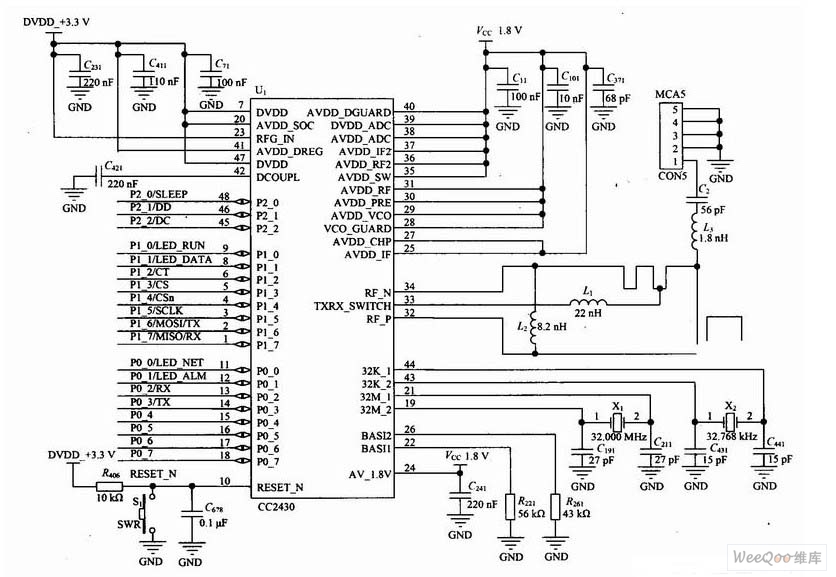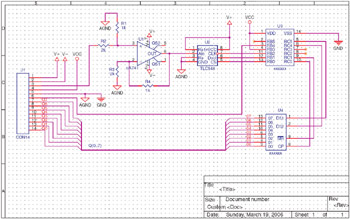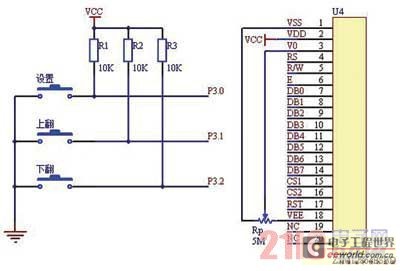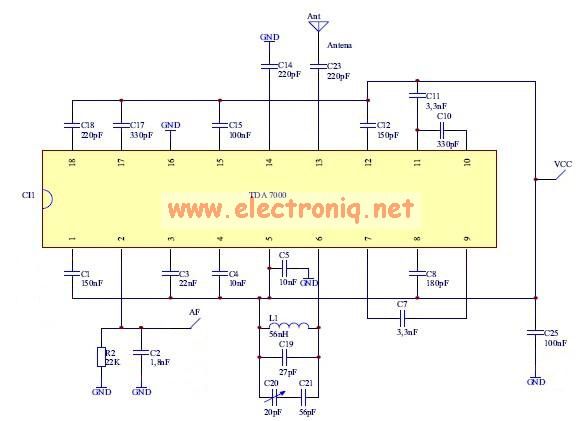
Electronics/Transmitter design
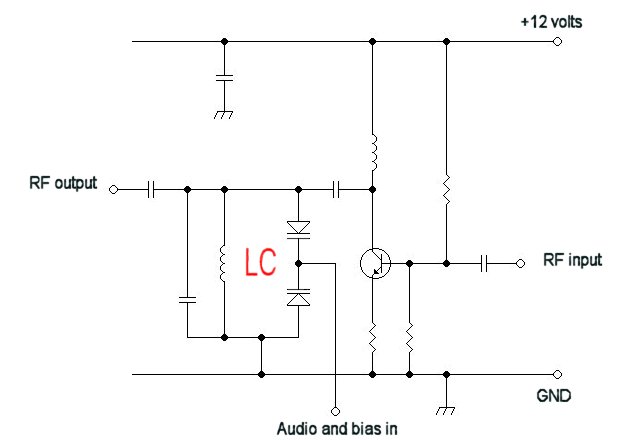
For a fixed frequency transmitter, a common method is to use a resonant quartz crystal in a crystal oscillator to establish the frequency. In transmitters where the frequency must be variable, several options are available. It is often the case for VHF transmitters that operating the crystal-controlled or variable frequency oscillator at the final output frequency is not feasible. Additionally, for reasons including frequency stability, it is preferable to multiply the frequency of the free-running oscillator to achieve the desired final frequency. If the output of an amplifier stage is tuned to a multiple of the frequency at which the stage is driven, the stage is optimized to yield a larger harmonic output compared to that found in a linear amplifier. In a push-push configuration, the output will only contain even harmonics, as the currents that would generate the fundamental and odd harmonics in this circuit (if one valve were removed) are canceled out by the second valve. It is important to note that bias supplies and neutralization have been omitted from diagrams for clarity. In practical systems, tetrodes are often employed since the plate-to-grid capacitance in a tetrode is lower, making the stage less prone to instability. The primary function of many transmitters is to convey some form of information using a carrier wave, a process known as modulation. Various types of RF modulation exist, with the choice often depending on the nature of the information being transmitted. For example, audio information is continuous in both time and value, allowing for acceptable scaling by a constant (e.g., signal inversion, volume control), thus making AM and FM transmission suitable. Conversely, for digital communications, where the signal is discrete in both time and value, inversion of the signal is unacceptable, rendering AM and FM inadequate on their own. In such cases, modulation schemes like frequency shift keying (FSK) or on-off keying (OOK) over FM are preferable. The advantage of utilizing a linear RF amplifier is that the smaller initial stages can be modulated, necessitating only a small audio amplifier to drive the modulator. However, this system's significant disadvantage is reduced efficiency, as the amplifier chain must remain linear to preserve modulation, thus precluding the use of Class C amplifiers. A method that combines the benefits of low-level modulation with the efficiency of a Class C power amplifier chain involves arranging a feedback system to compensate for the substantial distortion of the AM envelope. A simple detector at the transmitter output (which may consist of a loosely coupled diode) recovers the audio signal, which is then used as negative feedback to the audio modulator stage. Consequently, the overall chain behaves as a linear amplifier concerning the modulation, while the RF amplifier maintains Class C efficiency. This approach is widely implemented in practical medium power transmitters, such as AM radiotelephones. One advantage of employing Class C amplifiers in a broadcast AM transmitter is that only the final stage requires modulation, allowing all preceding stages to operate at a constant level. These Class C stages can generate the drive for the final stage with a smaller DC power input. However, in many designs, to achieve better quality AM, the penultimate RF stages may also need to be modulated alongside the final stage. A large audio amplifier, at least equal in power to the transmitter output, is typically required for the modulation stage. Traditionally, modulation is applied using an audio transformer, which can be bulky. Direct coupling from the audio amplifier is also feasible (known as a cascode arrangement), although this often necessitates a relatively high DC supply voltage (approximately 30V or more), which may not be suitable for mobile units.
The design of a variable frequency transmitter involves several critical components and configurations to ensure efficient operation and signal integrity. The core of the transmitter typically consists of a crystal oscillator, which stabilizes the frequency for fixed frequency applications. For variable frequency applications, additional circuitry may include varactor diodes or phase-locked loops (PLLs) that allow for fine-tuning of the output frequency based on the modulation requirements.
The amplifier stages are crucial in shaping the output signal. The use of push-pull configurations helps to minimize distortion and improve linearity, particularly in the context of harmonic generation. By optimizing the amplifier stages to operate at harmonic frequencies, the transmitter can achieve greater output power and efficiency. The choice of using tetrodes is significant due to their lower capacitance, which enhances stability and performance in high-frequency applications.
Modulation techniques play a vital role in the transmission of information. For analog signals, AM and FM modulation methods are prevalent, while digital signals require more sophisticated techniques such as FSK or OOK, which accommodate the discrete nature of digital data. The feedback mechanism employed in the modulation stage is essential for maintaining signal fidelity, especially when utilizing Class C amplifiers that inherently introduce non-linearities.
In practical applications, considerations such as power supply requirements, component selection, and overall system design must be addressed to ensure reliable operation. The integration of a feedback system not only enhances the modulation quality but also allows for the efficient use of power, which is particularly important in mobile and portable transmitter designs. Overall, the design and implementation of variable frequency transmitters require a careful balance of various engineering principles to achieve optimal performance.For a fixed frequency transmitter one commonly used method is to use a resonant quartz crystal in a Crystal oscillator to fix the frequency. For transmitter where the frequency has to be able to be varied then several options can be used. It is often the case for VHF transmitters that it is not possible to operate the crystal controlled or variabl
e frequency oscillator at the frequency of the final output. Also, for reasons including frequency stability, it is better to multiply the frequency of the free running oscillator up to the final frequency which is required. If the output of a amplifier stage is tuned to a multiple of the frequency which the stage is driven with, the stage is optimised to give a larger harmonic output than that found in a linear amplifier.
In a push-push stage, the output will only contain the even harmonics. This is because the currents which would generate the fundamental and the odd harmonics in this circuit (if one valve was removed) are canceled out by the second valve. Note that in these diagrams that the bias supplies and the neutralization have been omitted for clarity.
In a real system it is likely that tetrodes would be used as plate to grid capacitance in a tetrode is lower so making the stage less likely to be unstable. The task of many transmitters is to transmit some form of information using a carrier wave. This process is called modulation. There are many types of RF modulation, and the choice of modulation often depends on the type of information being transmitted.
For instance, audio information is continuous in time and value, and scaling by a constant (i. e. signal inversion, volume control) is acceptable, so AM and FM transmission work. But for digital communications, the signal is discrete in time and discrete in value, and inversion of the signal is unacceptable, so AM and FM are not (on their own) satisfactory. For digital communications, a modulation such as frequency shift keying (FSK) or on-off keying (OOK) over FM would be better.
The advantage of using a linear RF amplifier is that the smaller early stages can be modulated, which only requires a small audio amplifier to drive the modulator. The great disadvantage of this system is that the amplifier chain is less efficient, because it has to be linear to preserve the modulation.
Hence class C amplifiers cannot be employed. An approach which marries the advantages of low-level modulation with the efficiency of a Class C power amplifier chain is to arrange a feedback system to compensate for the substantial distortion of the AM envelope. A simple detector at the transmitter output (which can be little more than a loosely coupled diode) recovers the audio signal, and this is used as negative feedback to the audio modulator stage.
The overall chain then acts as a linear amplifier as far as the actual modulation is concerned, though the RF amplifier itself still retains the Class C efficiency. This approach is widely used in practical medium power transmitters, such as AM radiotelephones. One advantage of using class C amplifiers in a broadcast AM transmitter is that only the final stage needs to be modulated, and that all the earlier stages can be driven at a constant level.
These class C stages will be able to generate the drive for the final stage for a smaller DC power input. However in many designs in order to obtain better quality AM the penultimate RF stages will need to be subject to modulation as well as the final stage.
A large audio amplifier will be needed for the modulation stage, at least equal to the power of the transmitter output itself. Traditionally the modulation is applied using an audio transformer, and this can be bulky. Direct coupling from the audio amplifier is also possible (known as a cascode arrangement), though this usually requires quite a high DC supply voltage (say 30V or more), which is not suitable for mobile units.
A wide range o 🔗 External reference
The design of a variable frequency transmitter involves several critical components and configurations to ensure efficient operation and signal integrity. The core of the transmitter typically consists of a crystal oscillator, which stabilizes the frequency for fixed frequency applications. For variable frequency applications, additional circuitry may include varactor diodes or phase-locked loops (PLLs) that allow for fine-tuning of the output frequency based on the modulation requirements.
The amplifier stages are crucial in shaping the output signal. The use of push-pull configurations helps to minimize distortion and improve linearity, particularly in the context of harmonic generation. By optimizing the amplifier stages to operate at harmonic frequencies, the transmitter can achieve greater output power and efficiency. The choice of using tetrodes is significant due to their lower capacitance, which enhances stability and performance in high-frequency applications.
Modulation techniques play a vital role in the transmission of information. For analog signals, AM and FM modulation methods are prevalent, while digital signals require more sophisticated techniques such as FSK or OOK, which accommodate the discrete nature of digital data. The feedback mechanism employed in the modulation stage is essential for maintaining signal fidelity, especially when utilizing Class C amplifiers that inherently introduce non-linearities.
In practical applications, considerations such as power supply requirements, component selection, and overall system design must be addressed to ensure reliable operation. The integration of a feedback system not only enhances the modulation quality but also allows for the efficient use of power, which is particularly important in mobile and portable transmitter designs. Overall, the design and implementation of variable frequency transmitters require a careful balance of various engineering principles to achieve optimal performance.For a fixed frequency transmitter one commonly used method is to use a resonant quartz crystal in a Crystal oscillator to fix the frequency. For transmitter where the frequency has to be able to be varied then several options can be used. It is often the case for VHF transmitters that it is not possible to operate the crystal controlled or variabl
e frequency oscillator at the frequency of the final output. Also, for reasons including frequency stability, it is better to multiply the frequency of the free running oscillator up to the final frequency which is required. If the output of a amplifier stage is tuned to a multiple of the frequency which the stage is driven with, the stage is optimised to give a larger harmonic output than that found in a linear amplifier.
In a push-push stage, the output will only contain the even harmonics. This is because the currents which would generate the fundamental and the odd harmonics in this circuit (if one valve was removed) are canceled out by the second valve. Note that in these diagrams that the bias supplies and the neutralization have been omitted for clarity.
In a real system it is likely that tetrodes would be used as plate to grid capacitance in a tetrode is lower so making the stage less likely to be unstable. The task of many transmitters is to transmit some form of information using a carrier wave. This process is called modulation. There are many types of RF modulation, and the choice of modulation often depends on the type of information being transmitted.
For instance, audio information is continuous in time and value, and scaling by a constant (i. e. signal inversion, volume control) is acceptable, so AM and FM transmission work. But for digital communications, the signal is discrete in time and discrete in value, and inversion of the signal is unacceptable, so AM and FM are not (on their own) satisfactory. For digital communications, a modulation such as frequency shift keying (FSK) or on-off keying (OOK) over FM would be better.
The advantage of using a linear RF amplifier is that the smaller early stages can be modulated, which only requires a small audio amplifier to drive the modulator. The great disadvantage of this system is that the amplifier chain is less efficient, because it has to be linear to preserve the modulation.
Hence class C amplifiers cannot be employed. An approach which marries the advantages of low-level modulation with the efficiency of a Class C power amplifier chain is to arrange a feedback system to compensate for the substantial distortion of the AM envelope. A simple detector at the transmitter output (which can be little more than a loosely coupled diode) recovers the audio signal, and this is used as negative feedback to the audio modulator stage.
The overall chain then acts as a linear amplifier as far as the actual modulation is concerned, though the RF amplifier itself still retains the Class C efficiency. This approach is widely used in practical medium power transmitters, such as AM radiotelephones. One advantage of using class C amplifiers in a broadcast AM transmitter is that only the final stage needs to be modulated, and that all the earlier stages can be driven at a constant level.
These class C stages will be able to generate the drive for the final stage for a smaller DC power input. However in many designs in order to obtain better quality AM the penultimate RF stages will need to be subject to modulation as well as the final stage.
A large audio amplifier will be needed for the modulation stage, at least equal to the power of the transmitter output itself. Traditionally the modulation is applied using an audio transformer, and this can be bulky. Direct coupling from the audio amplifier is also possible (known as a cascode arrangement), though this usually requires quite a high DC supply voltage (say 30V or more), which is not suitable for mobile units.
A wide range o 🔗 External reference
Warning: include(partials/cookie-banner.php): Failed to open stream: Permission denied in /var/www/html/nextgr/view-circuit.php on line 713
Warning: include(): Failed opening 'partials/cookie-banner.php' for inclusion (include_path='.:/usr/share/php') in /var/www/html/nextgr/view-circuit.php on line 713
